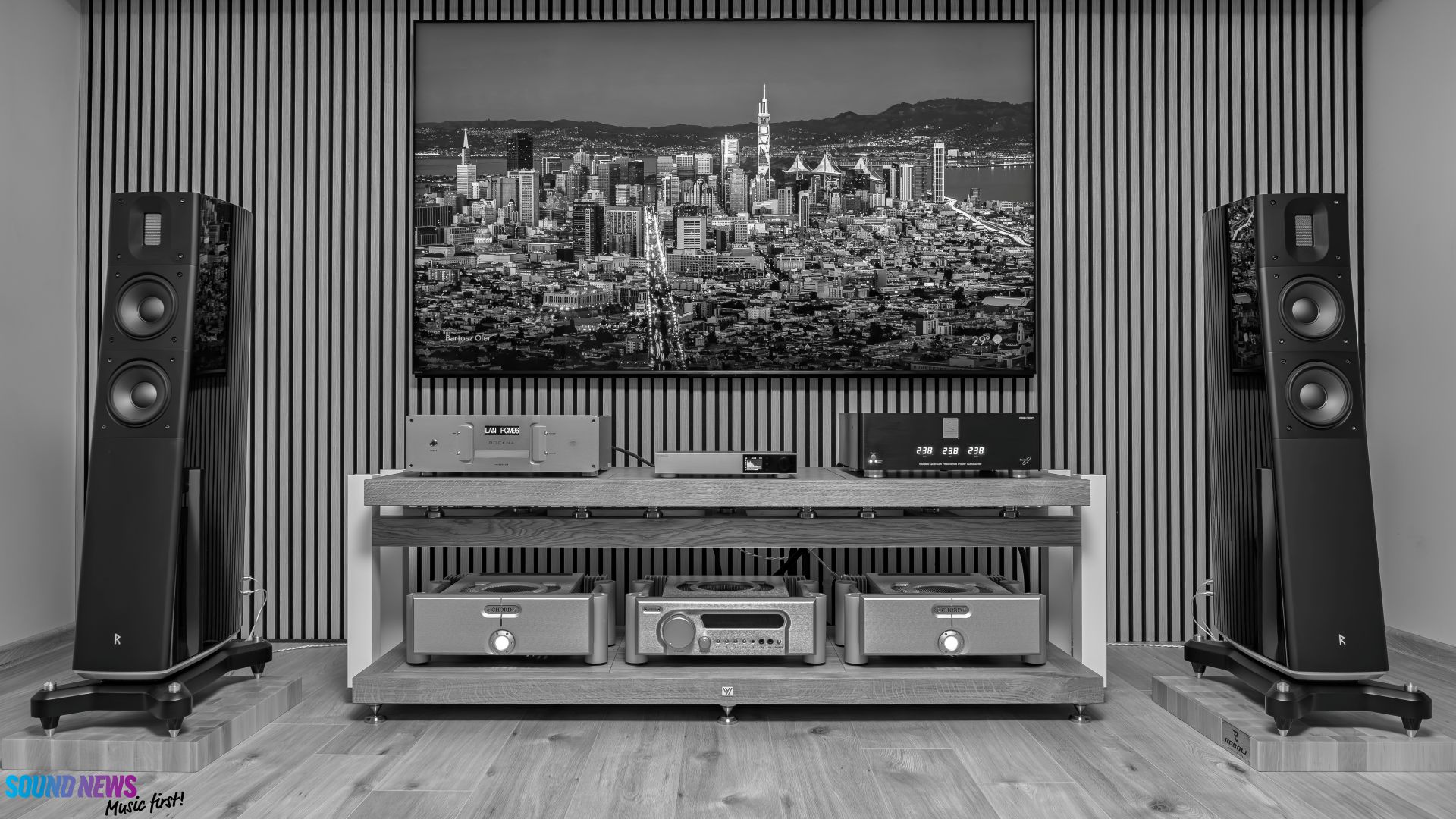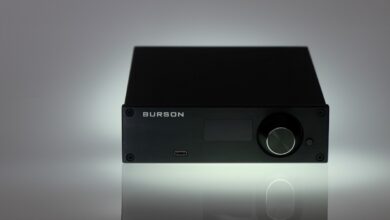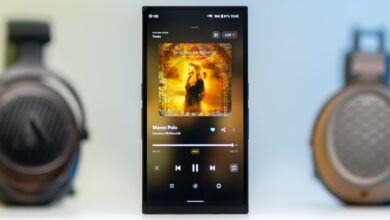
The summer vacation for the DACMan is over, and that means lots of DAC reviews will be coming soon-ish. And what would be a better way to kick things off than with the best DAC Topping Audio has ever made? Almost two years ago, Topping unleashed their mightiest DAC, the DX9, which carried 15 years of sonic expertise, sounding unlike anything they created before. It wasn’t only an impressively built unit with lots of bling for the eye and sonic wonder for the ear, it was also their most feature-packed unit. Rocking flagship-level OG AKM chips known for sweet sonics and lush tonality, including a fully discrete headphone amplifier section, it could be the last unit a head-fier would ever need. Being a limited-edition unit, it was only a matter of time before Topping would seek a successor, and while it’s not the DAC I will test today, it was the unit that started a small revolution among Topping Audio ranks.
It was the turning point for Topping, as they didn’t want to please audio tinkerers who swear by measurements, but also music maniacs who go with the flow and are into sweet vibes first, and everything else sits in the last place.
A couple of months ago, Topping proved that the time had come to unleash their true engineering skills, crafting a DAC from scratch. They no longer used off-the-shelf DAC chips but instead employed proprietary technology, producing their very first 1-bit PSRM modules and incorporating them into their D90 III Discrete DAC. That particular unit wasn’t only their latest DAC release, but their absolute first DAC build from scratch using their own single-bit D-to-A conversion technique; a brand new I/V conversion and output stage were also built from scratch, aiming for a sound that would again impress music lovers and audio nerds alike. The D90 III Discrete started a new chapter for Topping, one that would reinvent the brand and pave the road for a future flagship unit.
Enter the D900, Topping’s most simplistic yet complex DAC to date. While it borrows some technology from the D90 III Discrete and sonic attributes from the DX9 line, this is still quite a different animal, one that has been polished for more than three years now.
At the High End Show 2024 (more than two years ago), Topping was already showing off a working prototype for the D900, and after chatting with their Chief Engineer for a couple of minutes, it was clear to me that they didn’t want to rush things with their soon-to-be flagship unit. We don’t know for sure how much R&D was put into their best unit, but it’s safe to say that more than three years were poured into developing and fine-tuning the D900 to the final version, which I’m listening to at this very moment.
As a flagship unit that carries the latest tech advancements and some of the best DAC measurements, including an impressive case machining and industrial design, everything was reflected in the final price. For a while now, I’ve been constantly reminding you that a passive volume control or a digital attenuator has nothing to do with an active preamplifier stage, and that’s why I was recommending active preamplifiers to be used with power amps, instead of directly hooking a DAC to a power amp. There were a few exceptions to this formula, but usually a DAC + active preamp combo sounded considerably more expensive. Topping Audio, however, solved the biggest gripe I had with 99% DAC releases, including an actual active preamplifier stage into the D900! And now we’re talking about a must-have feature worthy of the flagship status.
The top-of-the-line D900 DAC will cost you €1.799 locally and $1.799 across the pond in the USA, and let’s check how it performs in both a stereo and a head-fi setup, and then compare it with a couple of units at a similar price.
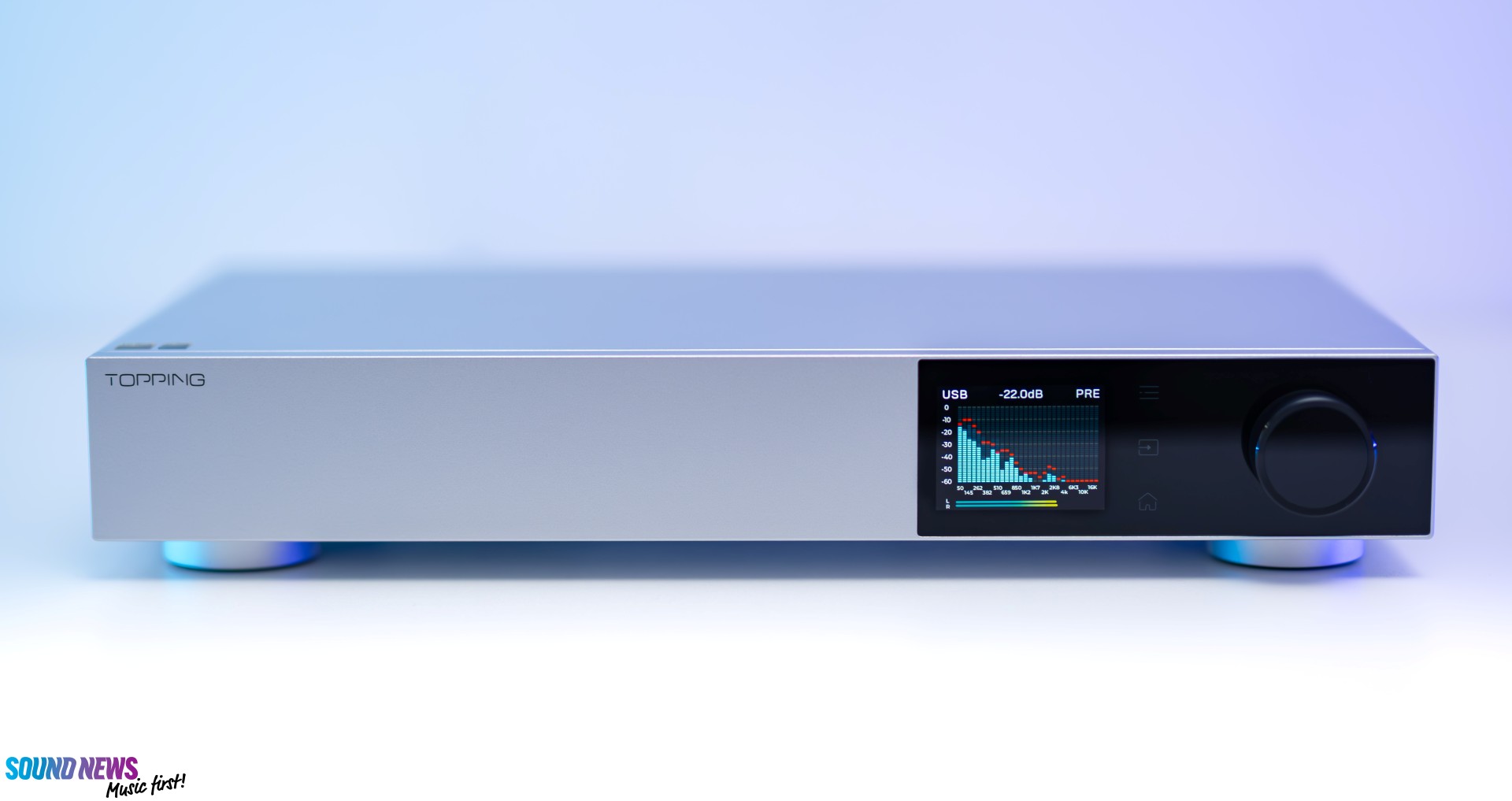
Design & Build Quality
For more than a year now, Topping has adopted a new design language, going with a brick-like case, starting with their D70 Pro and D70 Pro Octo, and then doing it again with the Centaurus R2R DAC. D900 goes with the same brick-like design that’s quite stealthy if you choose the matte-black color scheme. I got the silver version to review, mostly because the rest of my gear also has this raw silver look, which is much easier to put into focus when shooting photos and videos.
The D900 is, however, geared like a true flagship device from the ground up! Everything’s made out of thick aluminum, and yes! That includes the four feet that are wide enough, padded with rubber rings that will effectively nullify vibrations coming from within the unit. The case is milled on CNC machines from two pieces of aluminum that came together exactly in the middle of the case, where the heatsinks are located. The front panel has a thickness of 8mm, add 8mm-thick heatsinks, and a thickness of 3mm everywhere else, and we’re looking at a Faraday-cage-like unit that doesn’t care about wireless interference.
This is also a much beefier unit compared to your regular Topping units; it’s way bigger and heavier compared to the D90 or D70 line-up, and it’s almost identical to the DX9’s dimensions, being blockier and less rounded compared to the former flagship. It’s important to mention that we don’t have sharp edges anywhere, including on the front panel, so don’t worry about leaving a dent or a scratch, as that will be much harder compared to the EverSolo Play I reviewed a couple of weeks ago. Last but not least, the colorful and easy-to-navigate Aurora UI seems like a fantastic fit for the D900, including the touch-sensitive buttons near the volume wheel. You can even customize a button to your liking and let it function as an input selector, output selector, or output voltage selector. Its final function will be up to you to decide.
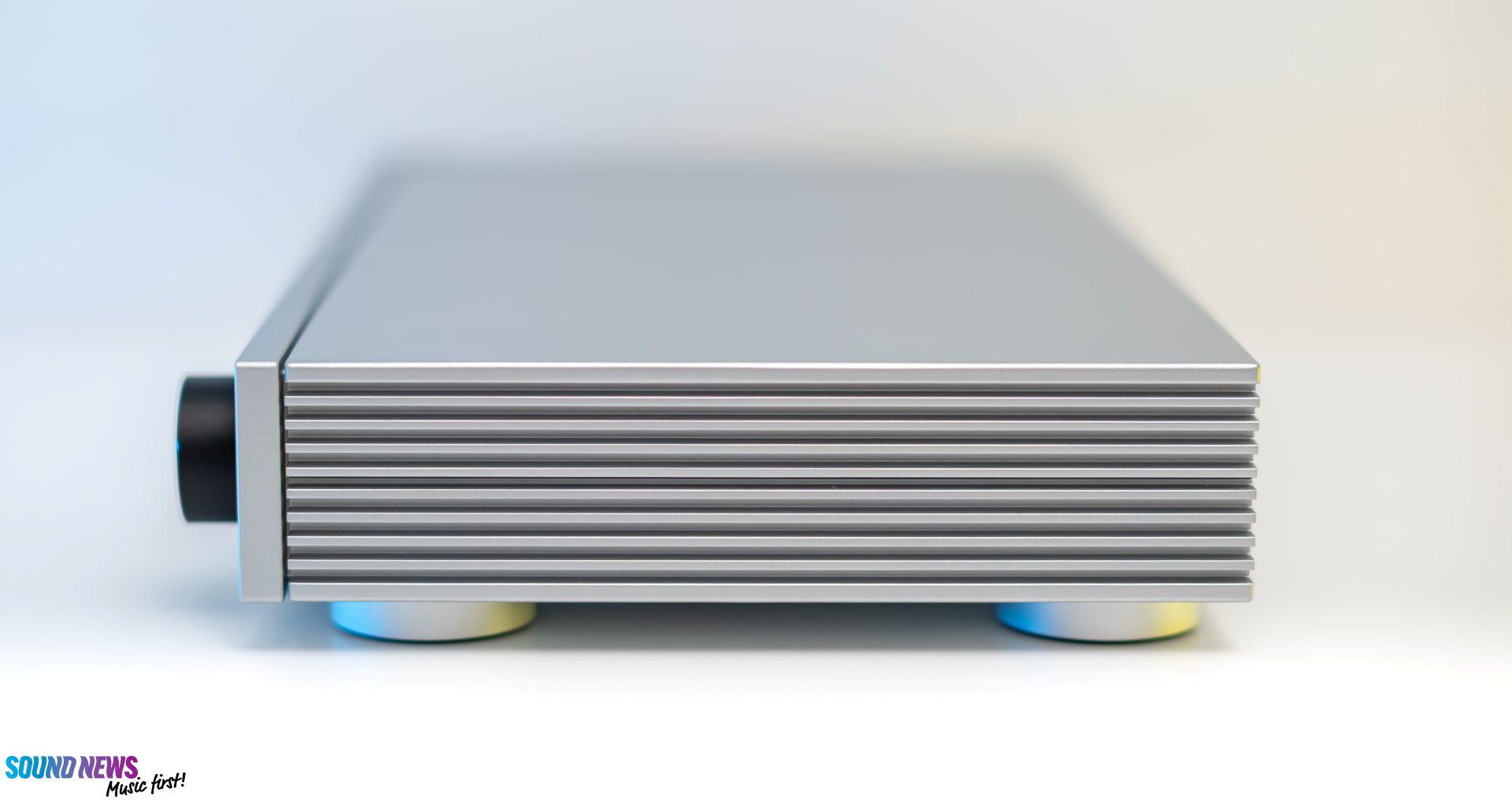
Overall, it’s less flashy and much less blingy looking compared to the DX9, and this might be a good or a bad thing, depending on whether you like to show off your gear or hide it from the cat eyes of our beloved. Personally, I enjoy its understated look as most high-end electronics aren’t about hundreds of LEDs, but about legendary sonics, and it seems that Topping chose the same formula.
Ooh, there’s one more thing that I forgot to mention – the fully CNC-machined RC-23 remote control bundled with every D900 is a beauty in disguise! After playing with tens of low-fi plasticky remotes, the RC-23 feels like a breath of fresh air. It’s carved from a single block of aluminum, it feels sturdy in the hand, and it’s a very well-made remote control. The buttons are rubberized and offer satisfying clicks; we have rounded corners, and it feels very premium in the hand.
Overall, this is one of the nicest-looking Topping units, combining amazing functionality, a rich feature set, and a great UI, garnishing it with outstanding looks worthy of its flagship status.
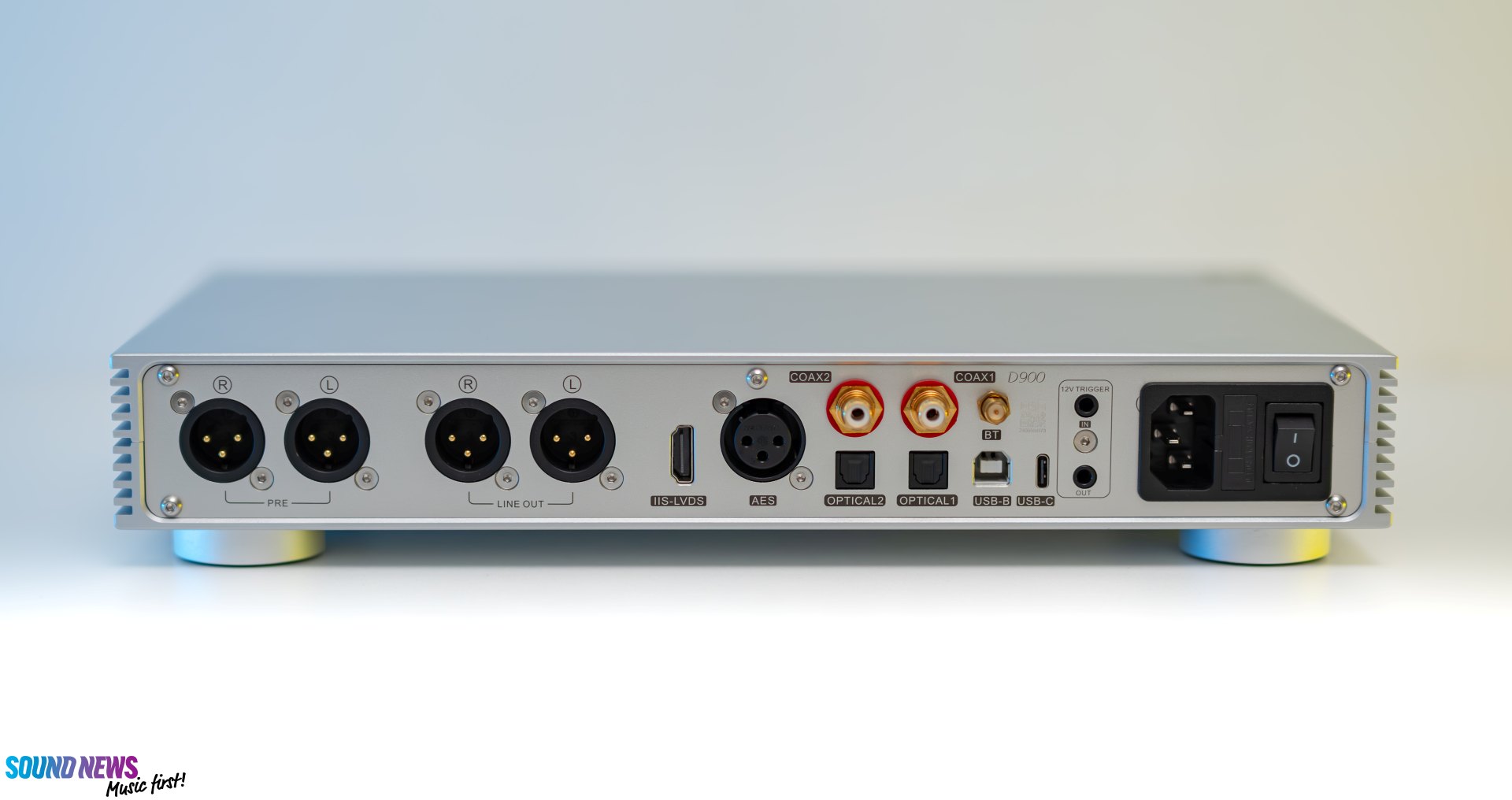
Controls & I/O
Controlling the D900 feels like a sea breeze: it’s smooth and relaxing. You can use the touch-sensitive buttons and the volume wheel to browse through its easy-to-understand UI, or you can use the metallic remote control. There aren’t hidden menus like it was the case with the D90 line-up; everything’s there for you to explore.
There are several themes to choose from. The default home screen can show an FFT spectrum (very cool to look at), it can be a VU meter or a simple basic info screen, displaying the sample rate, input, and output.
Apart from this, except for BNC, every possible digital input is located on its back, including the venerable I2S input, which I cherish so much. Coaxial and Optical inputs come in pairs, and there’s a Bluetooth antenna socket as well. Instead of the usual RCA and XLR analog line output that offers a fixed voltage output, we also have a pair of XLR preamp outputs that offer a variable voltage output. In case you’re using a power amplifier or two (monoblocks), then I recommend using the preamp outputs that will have nicer control over your power amps.
Additionally, there’s a 12V trigger input and output, just in case you want to power all your Topping devices with a single remote.
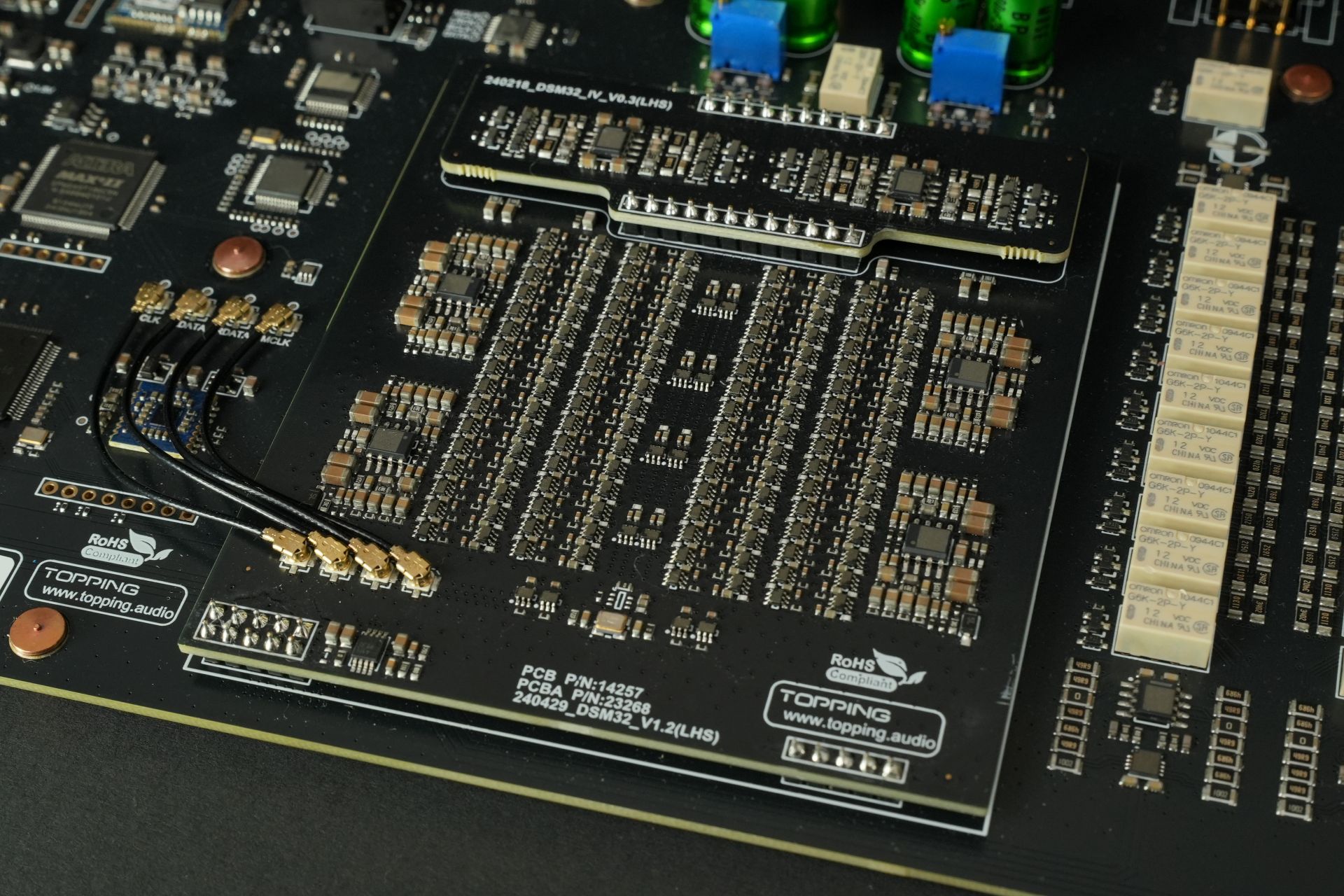
Under The Hood
With every DAC release, Topping is making sure that only their trained service workers will be able to open up their hoods. After removing every screw available, I was unable to remove the top cover, and since I don’t want to damage the internals or the ribbon cables that connect its display assembly to the main board, I will rely on the pictures I found online.
The most important thing to know is that instead of relying on off-the-shelf DAC chips that decode a digital signal into an analogue one, Topping decided to develop their own PSRM discrete 1-bit modules that convert a digital audio stream into an analog voltage by turning each audio sample into a very fast train of 1‑bit pulses whose density (the proportion of ones) represents the instant waveform level, then averaging/smoothing those pulses with an analog reconstruction filter. “PSRM” is Topping’s name for their proprietary implementation; the basic ideas are standard delta‑sigma seen in most modern DACs of today. This is only a short description of the working principle, and if this working principle reminds you of some other DAC manufacturer, then you would be totally right!
Topping’s PSRM discrete 1-bit approach and Chord’s Hugo/TT2/DAVE (the latter I owned for a couple of years) approach do the same fundamental thing: they convert the incoming digital audio into a very fast 1‑bit pulse stream, then use an analog reconstruction stage to turn that fast pulse stream back into a continuous voltage. But under the hood, they use different algorithms, implementation philosophies, and circuit choices, so they aren’t exactly the same.
On top of the PSRM modules, there’s a tiny daughter board that houses Topping’s new current-to-voltage (I/V) conversion circuit made out mostly from discrete components (naturally), with a couple of op-amps thrown in.
We again have the best Bluetooth receiver chip, capable of decoding some of the best codecs available today, such as LDAC, aptX Adaptive, and aptX HD. Topping implemented an FPGA chip that lets you use a parametric equalizer via 10 frequency bands. You can fine-tune the sound according to your preference or maybe according to some room acoustic measurements that you did. You can save these custom presets and load them into your unit. For that, you will need to install an app on your PC or MAC, called Topping Tune, connect your DAC to your PC or MAC via USB, launch the app, and from there, everything is straightforward. You can pick the frequency, adjust its gain and Q factor, and you can even add or remove a preamp gain; it’s up to you. The only thing you need to know is that the I2S input doesn’t support the parametric equalizer function, and every other input supports it for up to 192 kHz / 32-bit PCM files.
Last but not least, we have 18 analog relays (9 per channel), which provide 256 steps. The volume goes from -99 to +8dB (+8 dB of analog gain) in case you’ll use the preamp outputs. The preamp circuit is (again) made out of tons of discrete components, and overall, this is the best analog circuit Topping Audio has developed so far. If you’re wondering how much analog gain there is on tap. From 4.2V or 5.2V (depending on what you chose) via XLR, the voltage can go up to 10.5V (4.2V Mode) or 13V (5.2V Mode), respectively, effectively nullifying the need for a dedicated active preamplifier.
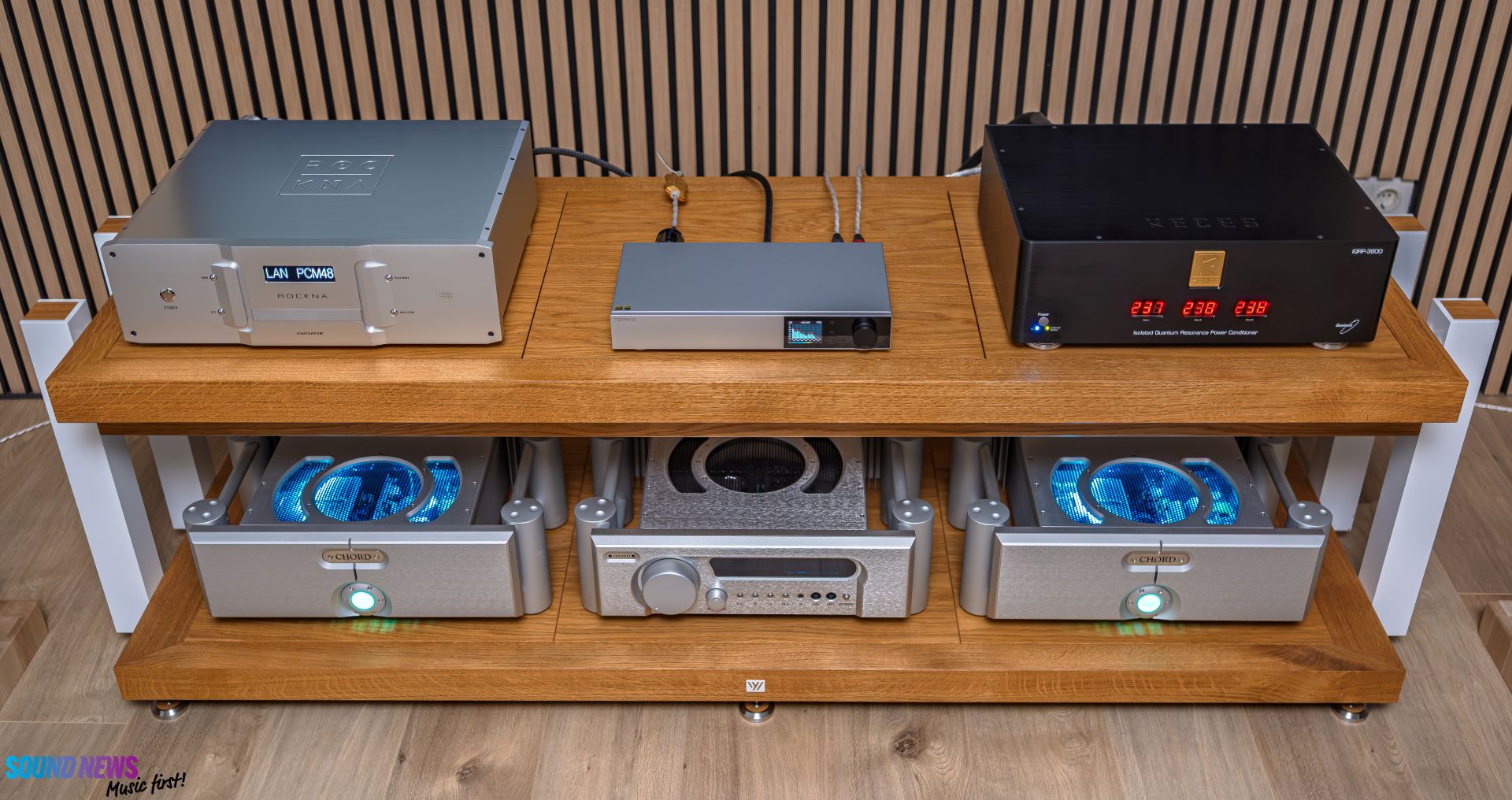
Test Equipment
Before you ask, D900 was used in a stereo rig most of the time, working as a standalone DAC and then as a DAC and dedicated preamp. Later on, I used it with the complementary A900 headphone amplifier with a bunch of dynamic and planar headphones.
In my office, it powered the A900 driving either the T+A Solitaire P or the HiFiMan Susvara Unveiled to strengthen my initial impressions.
In the living room, the D900 was fed via I2S from the Rockna Wavedream NET 4 Tb Roon server or the ONIX XTS20 CD/SACD transport, followed by a Chord Electronics Ultima 2 Preamp, a pair of Ultima 3 power amplifiers which in turn drove the majestic Raidho TD 2.2 loudspeakers, playing tunes for a full week before dropping my final evaluation. All cabling used was of Crystal Cable Monet breed (power, interconnect, Ethernet, and speaker cables). Everything was also powered by a KECES IQRP-3600 balanced power conditioner.
Everything’s clear as the blue sky, so let’s hit some eardrums!
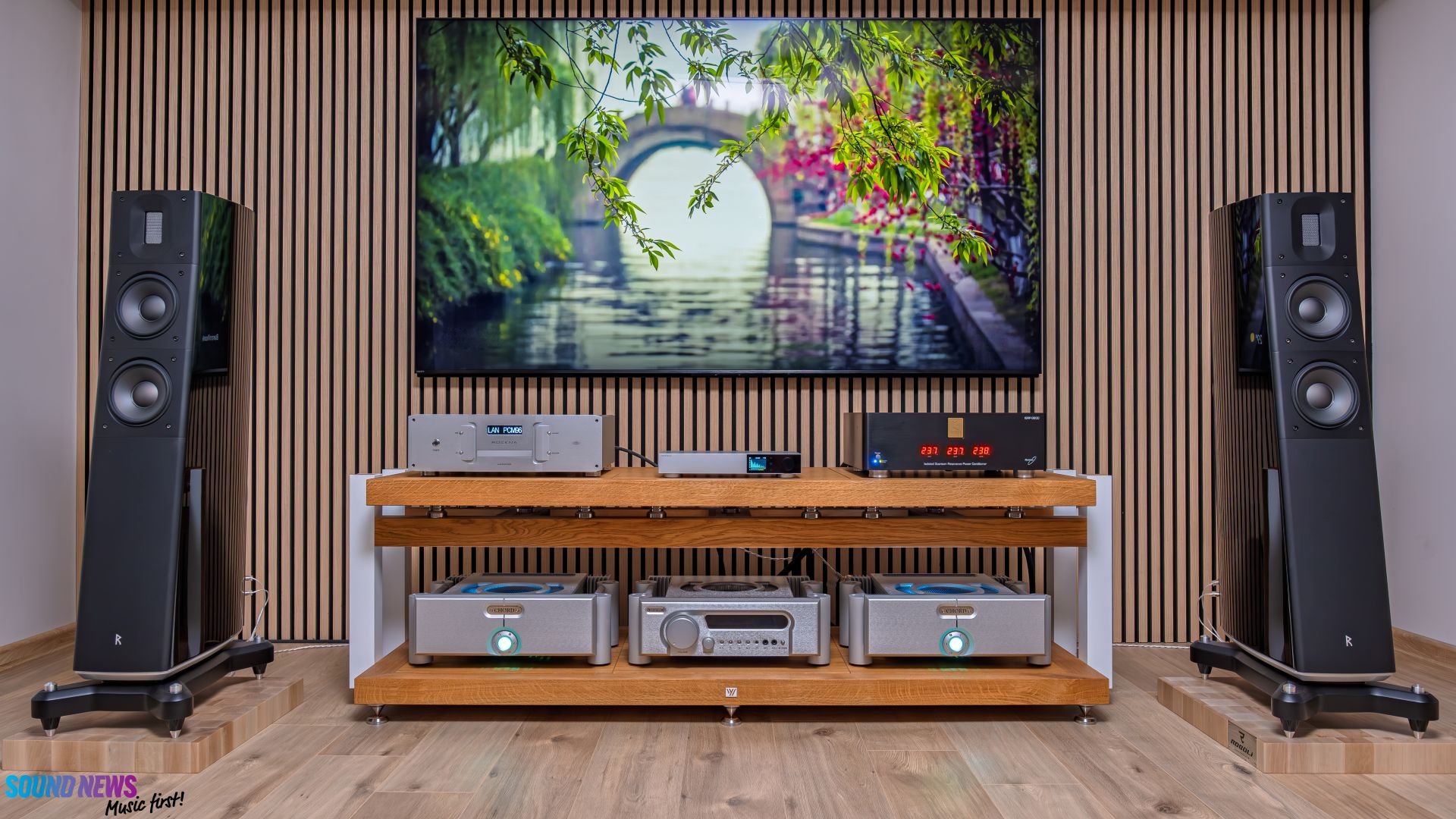
Sound Performance
I. Preliminary Sound Impressions
Describing the sound of the Topping D900 is no easy task, and let me explain to you why. These 1-bit software-defined DACs can be customized down to the smallest details, as every line of code tells it exactly when and what to do. With chip-based converters or R-2R ladder DACs, you cannot bypass some of their limitations, and you can’t customize them as deeply. An ESS-Sabre-based DAC will always sound like one, no matter what, and an R-2R ladder DAC would always sound by a hair thicker, slower, and more organic, regardless of the brand or price. A 1-bit delta-sigma DAC like this, however, will reveal its identity only after you put your ears to good use.
I did try a couple of single-bit DACs over the years, and you know what? All of them sounded different. An Audiobyte HydraVOX can’t be compared with a Chord’s DAVE or TT2, and all of these have nothing in common with the D90 III Discrete or D900, except for one BIG THING. All of these single-bit DACs have an interesting way of dealing with the rise, sustain, and decay of the musical notes, unlike anything else I have tried so far. The usual chip-based DACs with delta sigma modulators have the shortest sustain and note decays, hence being recommended for modern tunes when fast transients are the bread and butter.
These chip-based solutions, however, won’t be my no.1 recommendation when it comes to big orchestras, slow-paced music where tens of acoustic instruments interplay with a human voice or two. This is where big R2R DACs are ruling supreme, with long, beautiful decays that show off the inner textures of the musical instruments, including tiny intricacies of the human voice. They play slower, but much bigger, richer, and way more imposing, hitting harder as well. These R2R creations are also slowing down the pace, letting you enjoy a more relaxed presentation.
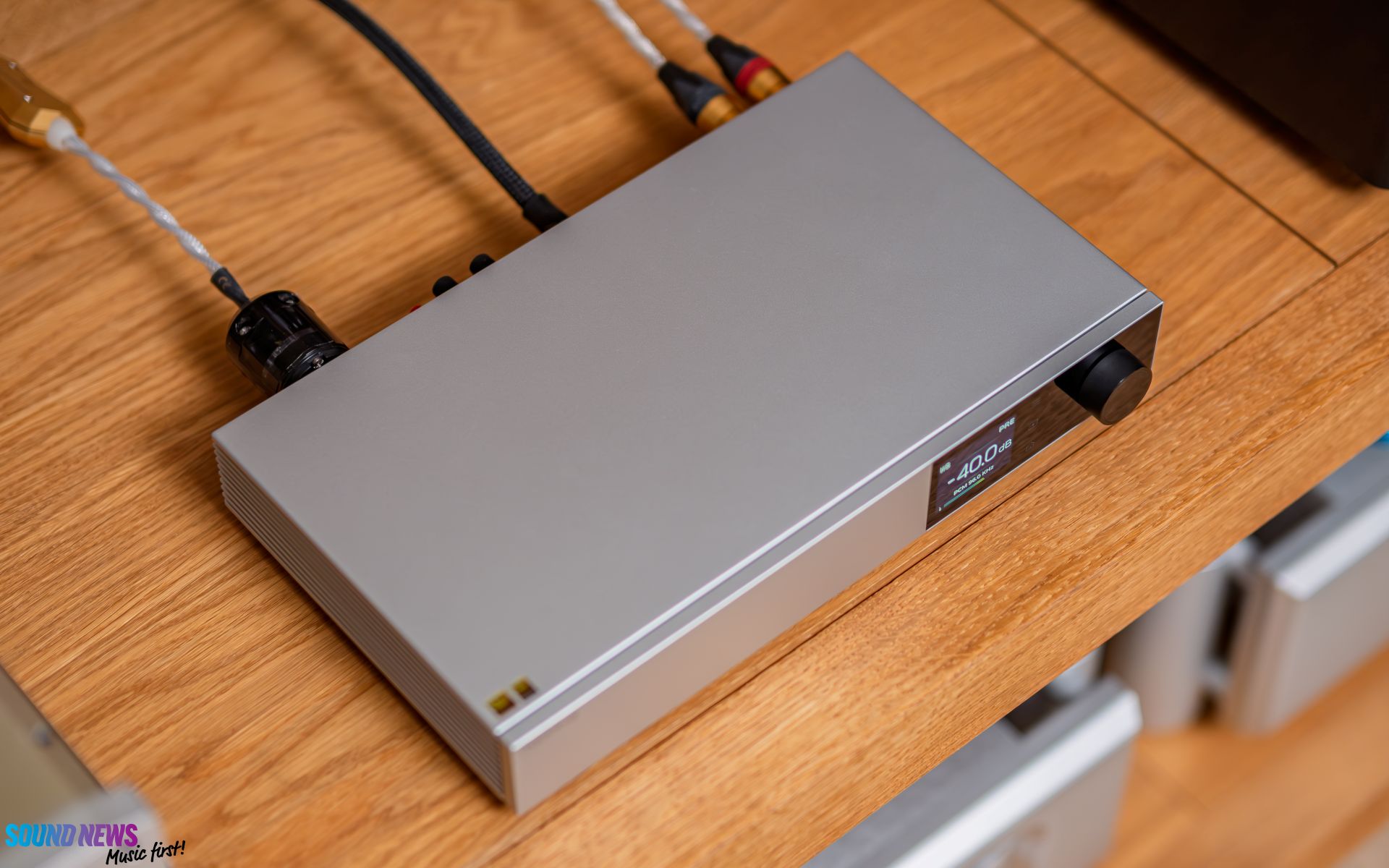
Alrighty, but how about these software-defined single-bit DACs? How do they fit in this big scheme of things? Well, imagine combining the speed of chip-based converters (with delta-sigma modulators) with the refinement, warmth, huge soundstage, and slower pace of R2R converters. And just like that *snaps fingers* you get the sound of single-bit DACs. Of course, I’m generalizing a bit in here, but this short description still stands so that you can get a general idea of their working principle and sound signature. I can certainly attest that the D900 has the lightning-fast transients of the Chord DAVE that I used to own for a couple of years, it has a similar flow with the Audiobyte HydraVOX that I also used to own, as if an invisible person is conducting the music for you, slowing it down and letting you fully relax or accelerating the pace for a more aggressive stance.
There’s another skill that D900 mastered quite well: it constantly removes the unwanted sharpness and excessive leading edge that chip-based solutions do now and then. If you’re coming from a first-generation D90 or from a D90 SE/LE, then you’ll observe a quantum leap forward towards a more refined sound across the board that further relaxes the body and soul, letting the sound flow like a butterfly midair.
Everything that has to do with impactful dynamics and fast transients was another surprise on the D900. You already know my insatiable desire for the ultimate speed, impact, and control of the drivers, in speakers or headphones form. I don’t like it when musical notes interfere with each other, creating an ugly low-fi mess. Entry-level R-2R converters are probably the slowest sounding of the bunch, but chip-based converters, however, lose lots of ground in the slam department, sounding lightweight and almost ethereal at times. With the D900 at the helm of my setup, there’s a sense that everything’s executed in perfect sync and timing, bringing a much-needed bass slam with the right music.
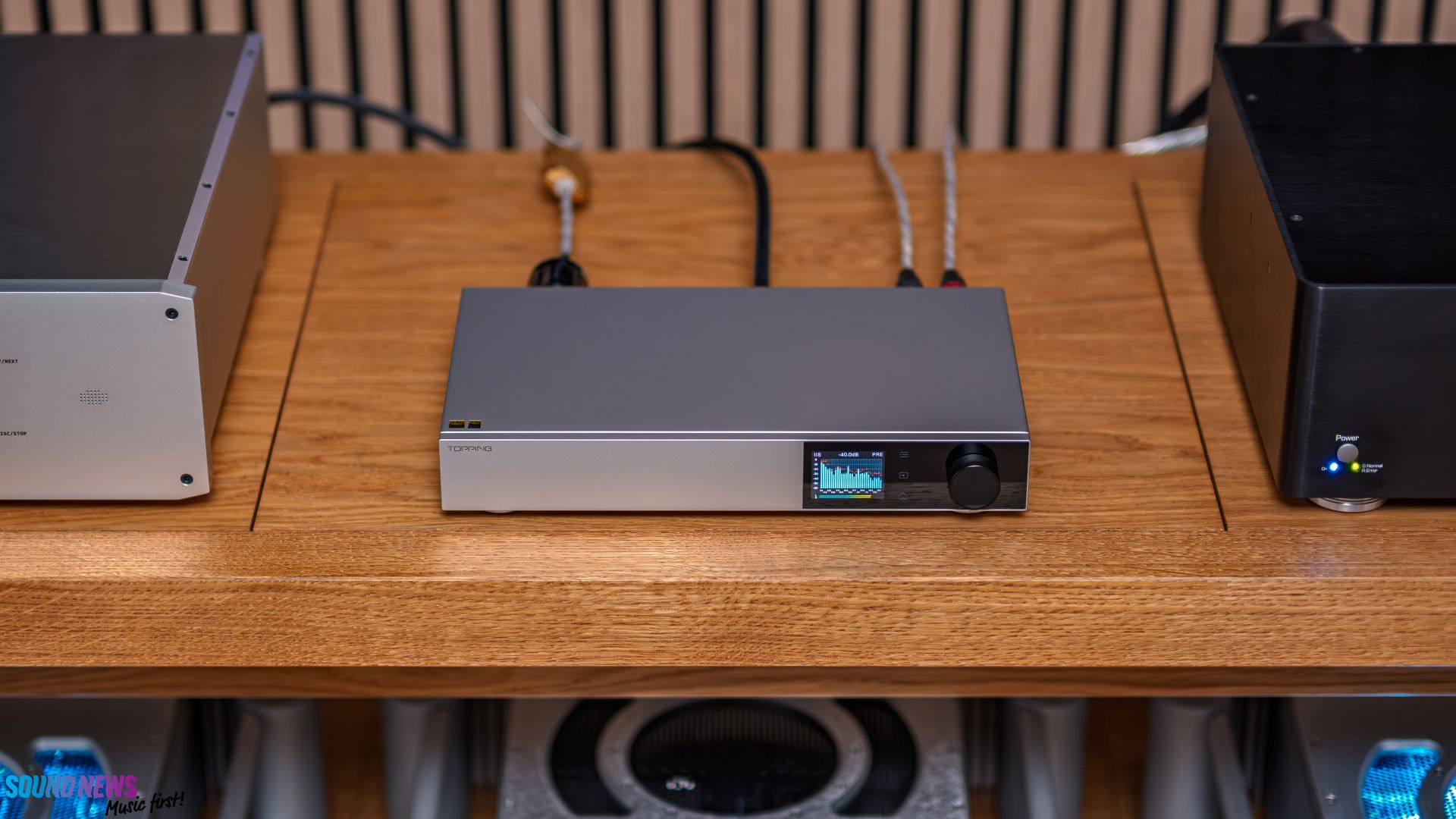
II. Topping D900’s Active Preamp
Knowing that the D900 already outperformed the DX9 when it came to detail retrieval, flow, soundstage, and later impact, I decided to remove my Chord Ultima 2 PRE and let the D900 do the heavy lifting, connecting the Ultima 3 monoblocks to its preamped XLR outputs and driving the same Raidho TD2.2.
Said and done! A couple of minutes later, and I was headbanging to a similar groove. The energy levels didn’t go down as expected, the soundstage didn’t collapse on me, and the naturalness and tone thickness didn’t disappear. So, what changed then? I needed to raise the volume a bit higher versus the Ultima PRE2 and considerably higher versus the Rockna Wavedream Reference Signature + Ultima Pre2.
The music lost a bit of the tightness of world-class preamps, and some of the organic matter was also missing the (G) spot, sounding less refined and not as sweet, nor as organic as reference-grade preamps…but the sound was nowhere near dry, thin, or ethereal. I could still hear the nice control, the impressive soundstage, still shooting for the stars with my speakers. I could still experience an impressive stereo separation and depth even with studio albums. I think Topping did a marvelous job with the preamp section, and if you don’t have as much power on tap as I have, don’t worry, as there are still 8 dB of analog gain remaining on tap that I didn’t even touch, as the sound was already way too loud.
A local band just revealed a new single that’s so fitting for the summer time and the heat wave Europe is fighting with. Hameiul Fermecat by Subcarpați (here it is on Qobuz and Tidal) starts playing, and to tell you the truth…I was not prepared for such a powerful drum and guitar solo right from the start that set the groove for the rest of the track. The song pays tribute to hops in their usual folkloric way, mixing a cold beer with deep vocals, local folklore, hip-hop, and lots of rock. It’s a recipe for a fun-tastic rhythm, pace, and timing, and you know what? D900 didn’t break a sweat, sounding vivid and alive, exactly as I had envisioned. Minimal was the effort, maximum was the outcome, and even if I’m not dealing with overly complex music, the tonal density was high, the vocals sounded right to me, and the rhythm never lost a beat. I can’t complain, D900 was made for complex and easy-going music alike, and the energy levels still remained high no matter what.
Christian McBride’s Big Band slowly started releasing the tracks for the upcoming album – Without Further Ado Vol.1, and why not, let’s give it a try. Murder by Numbers and then Old Folks (found on Qobuz and Tidal) are exactly what you would expect from McBride. Slow, powerful, extremely textured, you could almost taste the wood, copper, and bronze in your mouth. Big sounds, even bigger vocals, all nicely portrayed all around me. It’s slowly becoming clear to me that D900 isn’t only a very technical-sounding DAC, but a unit that can show the beauty within every track, be it slow or fast, old or new.

III. Soundstage & Imaging
I have always felt that there is a strong correlation between “a big sound” that can stretch wide open and the channel crosstalk a DAC produces. The lower the channel crosstalk distortion is on a DAC, the wider and deeper the music will become. Obviously, this is another generalization. However, you should know that so far, I haven’t experienced a “small-sounding” DAC that had a super low channel crosstalk. Not yet, at least. DX9 has it as – 125 dB via XLR outputs, D900, however, proclaims itself with a much lower channel crosstalk distortion of -147 dB via either line outs or Pre outs. That’s a 22 dB difference, and while these numbers won’t tell you how much better the D900 can perform in real life, I can attest that the sounds fly off more easily on the D900. And let’s not forget how impressive the DX9 was in this regard, and it still is! Imagine a DX9 on steroids, that not only plays a bit cleaner, faster, and more impactful, but a more 3D sounding unit that pushes your imagination further with every live recording, and that’s how you get the D900.
Naturally, I’m exaggerating a little so you can understand what I’m hearing at this moment, but clearly, this is a huge achievement in Topping’s portfolio, as I never hailed Topping too high in this regard. Except for their DX9, D70 Octo, and E70 Velvet (and maybe a few more), I was never quite excited about the way they deal with stereo effects. Having a precise imagining is no longer that difficult; a few entry to mid-level converters already do it properly, but having an out-of-head experience via headphones or looking over my shoulder via loudspeakers rarely happens with a Topping unit, and I can only congratulate them for a different presentation this time around.
I’ll go as far as to say that the D900 sounds more 3D and holographic compared to the Chord DAVE (without the M Scaler), and it’s more or less on the same level as good-sounding R2R ladder DACs like the Gustard R26, and let me give you an example.
This is maybe not the best recorded album of David Gilmour, but I still love it to bits! Once Luck and Strange start playing, the only thing remaining to do is to pour an old drink, recline my chair, pull a cigar, and nod my head once in a while with a huge grin on my face. There’s a single track released just a couple of days ago, recorded from a live concert (here it is on Qobuz and Tidal) that, instead of adding depth like all David Gilmour’s albums do, added width. Lots of it. It’s a long track, so prepare to get in the mood; the mastering and mixing are great. The sound interplay is epic, and the riffs are legendary; everything breathes naturally, even my Hay Fever is not stopping me from enjoying the added air and flair. Clearly, the D900 wasn’t molded only for modern tracks like its predecessors did; it’s very capable at showing off the beauty behind live tunes like this. Don’t stop now, follow this track with Live At Pompeii and become a Gilmour follower. He’s truly a living legend.
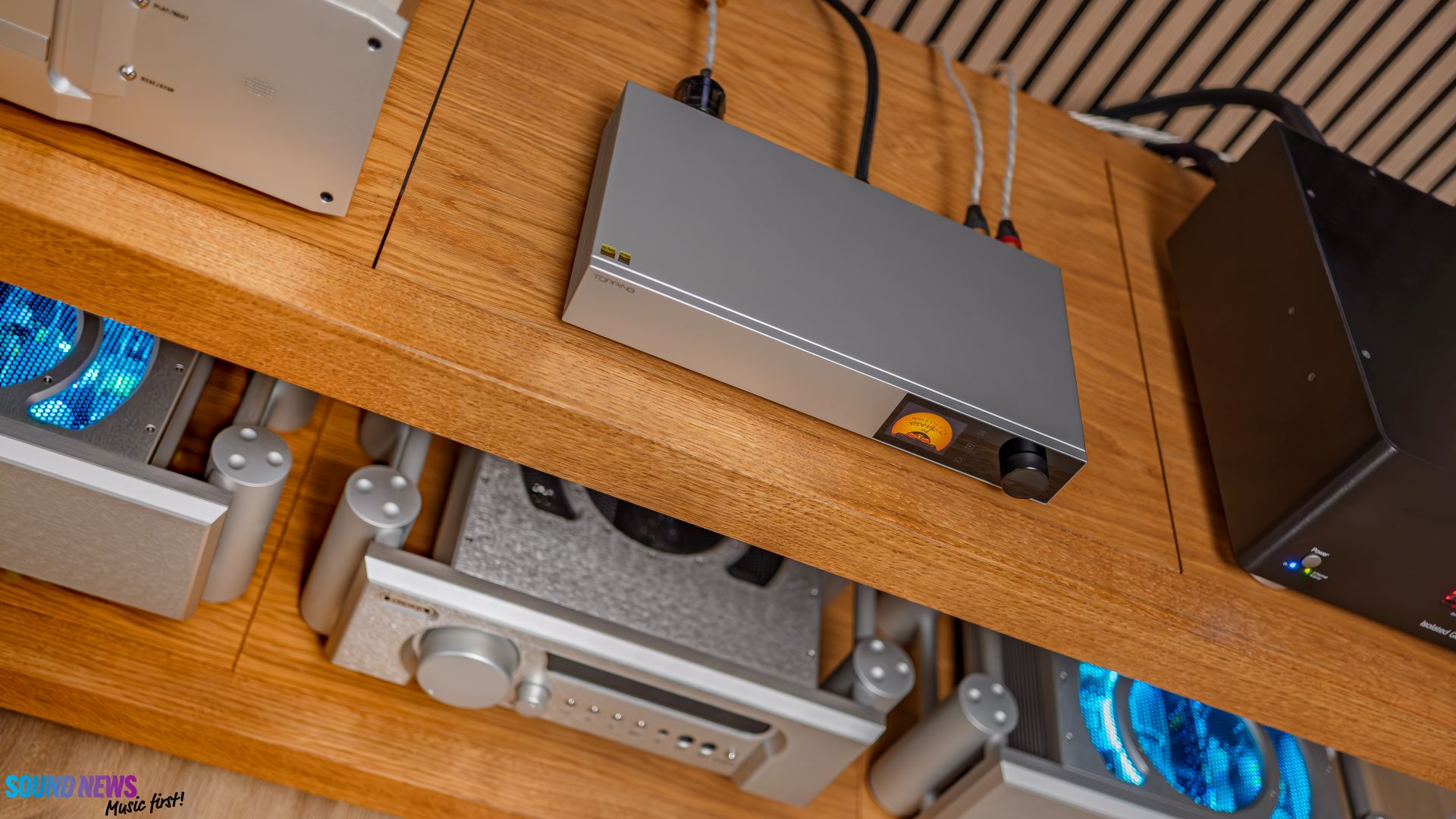
IV. Dynamics & Transients
Don’t Wanna Go Home (feat. Joe Bonamassa) by Eric Gales (found on Qobuz and Tidal) is such a powerful tune in the true meaning of the word, that even in the first ten seconds of play, you’ll realize the energy levels rising in the room, and it should put a big smile on your face. That thump, that slap in the chest, that bass line, seriously now, funk rarely sounds like this. I could use much faster tunes and much harder slamming ones as well, but that’s not the main point.
Over the years, I realized that most Topping DACs will impress you with fast, relentless transients, even if they don’t cost you more than a pair of entry-level interconnect cables. Their short signal path, combined with the simplicity of their (tiny) circuits, will always lead to impeccable timing and fast transients no matter what. Sounding snappy and instantaneous were core skills of the Topping family. The only part where Topping DACs lacked in a direct comparison with similarly priced converters was the physicality of the sound, how much air they were able to push short or long term. How painful the kicks below the belt can get with wild electronica, and how much gutturalness can you feel while playing Leonard Cohen? All of these things weren’t so goose-bump-inducing on Topping units. I’m not sure if it was their weak I/V conversion or LPF stage, or the power supply implementation wasn’t up to snuff, but the sound was never trying to move mountains or your body to its core. With a few exceptions like DX9 (and D90 III Discrete to some degree), the sound was polite and light-footed, and while that’s okay for affordable stuff, it’s no longer agreeable once you go past ~$1000 or along those lines.
The D900? It’s more impressive in this regard, it’s not quite there yet with $3000 units like Gustard X30 for example and it’s not exactly as raw and physical like the R26 can get, but it’s leaping forward with huge steps, to a point of guessing a sound difference between these units on select tracks that put a big accent on the physical aspect of music listening. The D900 finally gets me grooving, there’s more muscle mass with thumpy tunes, there’s more energy with high dynamic range tracks, and a bass line that’s playful and punchy when needed. This is undeniably Topping’s best when it comes to dynamics, and once you pair it with the A900 in a head-fi battle station powering a demanding pair of planar headphones, you’ll hardly put your headphones down. This duo has been dominating my playlists for a week now, and I can’t think of a better combo right now.
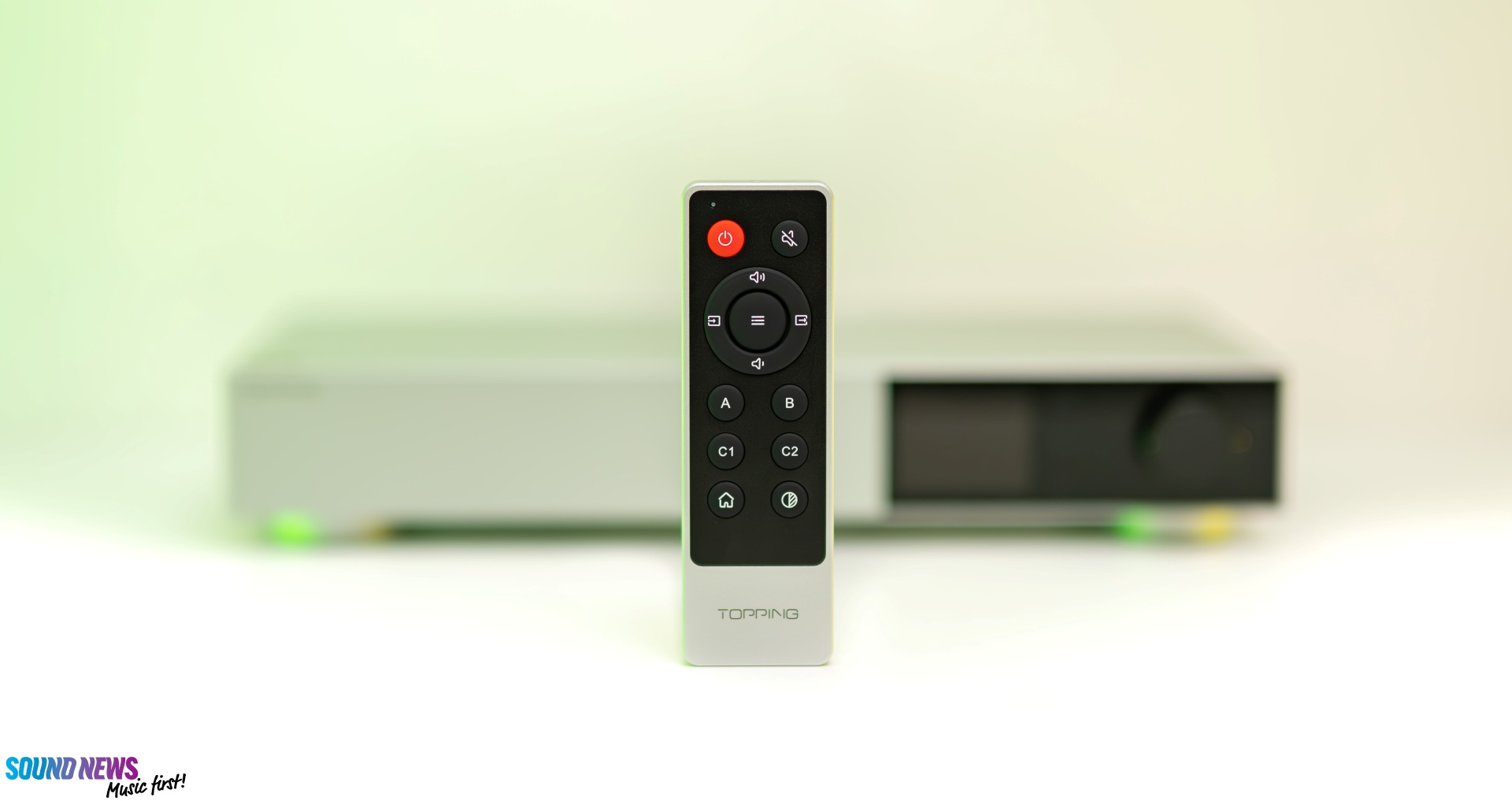
V. Detail Retrieval & Transparency
This is by far the easiest chapter to write about. From day one to day seven, no matter what track I used, what headphones or loudspeakers, the D900 was always trying to extract as much information as possible from the original file. If all you care about is hearing all and everything with as little coloration as possible, while retaining impeccable timing, then it would be a challenge to recommend something more expensive than the D900. It’s shocking how much “more music” there is with the D900 once you start comparing it with lower-priced converters. The DX9 might win you over with a thicker tone and timber, but it’s nowhere near as resolving and as clear-sounding as the D900. To tell you the full truth, there are things that my Rockna Reference Signature DAC does A LOT better, but when it comes to sheer resolution and dynamic range, these two are playing at a similar level, even if one is ~15 times more expensive. The inner details oozing from the D900 are shocking not only when it comes to their raw numbers, like how much more information there is behind your music, but also how real and unobtrusive that information is, revealing itself. Don’t expect to get a sharper treble, because you won’t get one. You’ll get more inner detail without raising the sharpness to alarming levels. Super high resolution is not about sharp trebles; it’s about more information coming from the entirety of the frequency response. Including from the bass and midrange, and that’s exactly what I’m getting from the D900 in a direct comparison with the DX9 and to a smaller degree compared to the D90 III Discrete. Even the D70 PRO ESS doesn’t stand a chance on both PCM and DSD material; there’s simply more information, like looking at a higher resolution picture, and you can zoom in and out a lot easier than a lower-res one.
But here comes the cool part. Sometimes people call their highly resolving DACs clinical or ruthless, incapable of rendering well low-fi material or bad masters and mixes. The cool part is that I’m playing such low-fi tunes on a daily basis, all things rock and metal are playing here on repeat. That’s my audiophile diet, nothing I can do about it. Some of these uber-resolving DACs play well with such content, and some of them don’t play well with poorly mastered music. The D900 isn’t forcing me to skip a track or two, and it’s not forcing me to lower the volume either! Be it Iron Maiden or Metallica, I raise the volume up and it’s making me feel great. D70 PRO couldn’t do that, D90 SE couldn’t do that either. DX9 did that much better, and so is the D900. Topping’s flagship DAC isn’t making you select only the best music, from the best record label, in the highest sample rate. You don’t care about this part anymore; any underground back will sound just fine, highlighting the parts of why you fell in love with that particular track or album. It doesn’t force you to skip some of the music; instead, it makes your nights shorter, and I love it for that.
Ever since experiencing Earth Melodies by Ekaterina Shelehova, something changed inside me. How can a female voice pass on so much energy without saying a single word… is beyond me. She’s currently working on her next project. You could already try the first single from the upcoming Savage Daughter album (here it is on Qobuz and Tidal). I no longer need to hear her singing prehistoric rhythms; she’s finally singing in a language we can all understand. The mastering seems great, and her voice seems dead centered. Around mid-track, she starts reaching much higher frequencies, accompanied by backing vocals and lots of percussion work. Although oversimplified at the start, it gets complex at the very end, and even with so many instruments and voices interplaying with each other, you could still focus on a single note from start to finish. The D900’s ability to let you focus on a single note in busy passages is laudable; this is how you differentiate a good DAC from an outstanding one. A job well done!
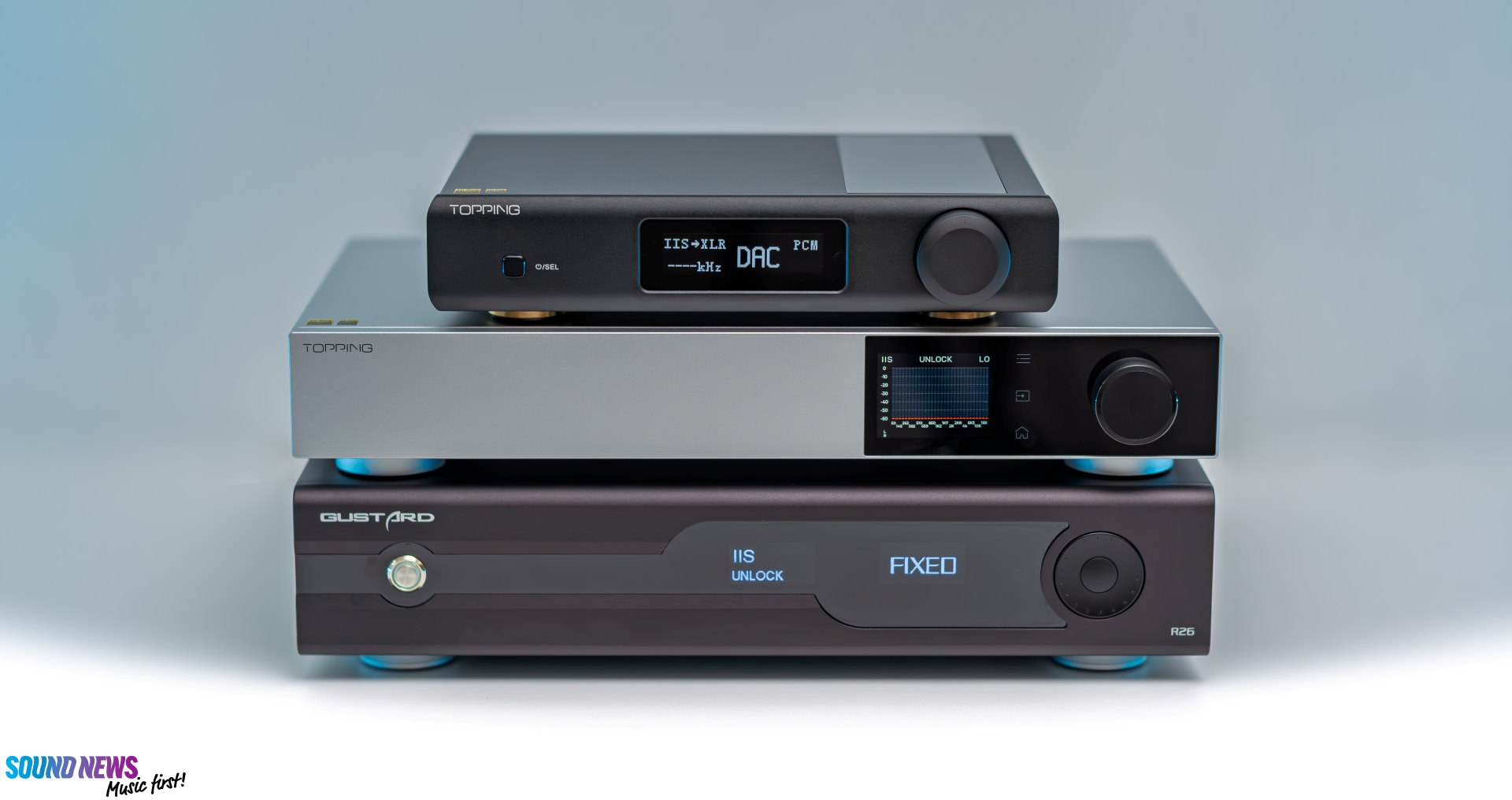
VI. Comparisons
I’m already picturing a crowd asking in unison how the D900 compares to the X, Y, and Z. However, take into consideration that everything reviewed around here isn’t always purchased after our evaluations. However, I still feel obliged to compare it with its smaller brother, D90 III DISCRETE, and also with the unit that made the biggest splashes around here two years ago – the Gustard R26. The latter is an R2R ladder DAC, so I’ll be comparing apples with oranges, but still, I know many of you are wondering about this showdown, so let’s get this party started.
Topping D900 ($1.799) VS Topping D90 III DISCRETE ($999) VS Gustard R26 ($1.649)
First and foremost, the D900 is more expensive than the rest, almost twice compared to its smaller sibling, and as such, it not only needs to sound better, but it needs to be so much more feature-wise.
I won’t touch base about their looks and build quality. I will only say that the D90 III Discrete (D90 from now on) feels a bit outdated with that monochrome UI and plasticky remote control. D900 feels more sophisticated, inside and out; not a single design choice or UI element was left by chance, everything was carefully selected to reflect its flagship status. The R26 is also quite a solid piece of technology, built to high standards. The only things that bother me are the plasticky remote control and the weirdly arranged tempered glass on the front panel, triggering my OCD. The newer X26 III and X30 looked better to me, getting simpler and fully symmetrical, and I hope the upcoming R30 will further polish the look of its predecessors, but more about that in a month.
One important aspect that Topping took seriously with the D900 is the heat dissipation. In a room temperature of 28°C, after 8 hours of non-stop music playback, the hottest spot I measured with D900 was 37.5 °C – slightly warmer than our body temperature, and sure enough, you can place the complimentary A900 on top, or any other headphone amplifier with a similar footprint. Unfortunately, you cannot do that with the Gustard R26, as it reaches ~50°C in less than 2 hours. Biased mostly in Class-A operation, the output stage gets hot, and the voltage regulators and discrete components are also generating lots of heat that has nowhere to go but up. The lateral heatsinks help with the heat dissipation, but I would advise against putting anything on top of the R26. The D90 is pretty much in line with the D900; the I/V and LPF aren’t biased with lots of current, so these will work just fine 24 hours a day without catching fire.
Feature-wise, the D900 again takes the lead as you can find almost every possible digital input (except for BNC) and analog output, there’s even a pair of dedicated preamp outputs that neither D90 nor R26 has. If you’re rocking power amplifiers as I do, then choosing the D900 over the rest seems like a logical move if you don’t want to invest too much into your hobby. R26 was the first Gustard that implemented a streaming module that was further refined in the X30 and X26 III. It was fine back in the day, but it lacks the quality-of-life improvements that came later on. It’s still Roon enabled, it can do AirPlay, UPnP, and NAA, and if that’s important to you, then R26 might still appeal to lots of folks. It would have been cooler to have a Chromecast built-in, Tidal Connect, Qobuz Connect, and Spotify Connect options for a true future-fi unit, but hopefully, they’ll learn from their past mistakes.
Lastly, I’m reminding you that D90 is also a single-bit DAC with a custom delta-sigma modulator installed, while R26 is a veritable R2R ladder DAC that converts the digital signals in a very different way.
Sound-wise, if the only thing that matters to you is detail retrieval and sound transparency without leaning to the bright or dark side, then D900 takes the throne as the most revealing DAC I’ve experienced so far up to $3000. It’s shocking how much “more music” there is on the D900 versus the R26. I will never call R26 muddy or muffled-sounding, as if putting a thin veil around my ears when listening to music, but it feels that way when comparing the R26 with the D900. The D90 is much closer to the D900 than to the Gustard, and to nobody’s surprise, the D90 is also the most revealing unit I’ve experienced up to ~$1500 or along those lines.
Apart from being super clean, it’s obvious that the outline of the notes and also the inner details were mildly boosted on the Toppings, while the Gustard is much smoother-sounding, hiding some of these intricacies along the way, like applying some sort of anti-aliasing filters to the music. R26 works great with absolutely every musical genre, at the cost of not hearing every nuance and detail with a magnifying glass.
Both D90 and D900 do that without boosting treble sharpness, although D900 does it better, completely removing the grain and listening fatigue. D90 III isn’t exactly a silver surfer, and to my ears, it’s the one leaning towards the “digital side”, appearing a bit less organic sounding versus the rest. The flow of the music is best experienced on the D900, R26 comes next, and D90 is slightly lagging.
The tonal balance is, however, quite a different animal on the R26. This is the richest and sweetest-sounding unit of the bunch. The midrange region in particular feels boosted, not only moving the vocals a step forward, but also boosting their textures, adding longer trails to them, and to everything else. It’s the slowest sounding DAC from this trio, but also the mellowest, smoothest, and it’s the one that can be described as “musical”, trying to impress a lot more with music’s flow and beauty, rather than with impressive technicalities such as fast transients, accurate timing, or impressive detail retrieval. The mid-bass is also by a hair elevated on the R26, and with a pair of bookshelf speakers, the R26 will appear punchier sounding, adding more oomph and bass energy that is beneficial to most HiFi systems. I certainly like the effect, as it’s the one that’s on the fun side of music listening.
Both Topping devices are a bit more serious, trying to stay closer to neutrality, but without becoming clinical or dry. However, the D900 isn’t as lean as the D90, still offering a higher definition and texture compared to the D90, bringing back some organic matter that is not quite there on the D90. For example, if I listen to old recordings with lots of grain and imperfections, D900 manages to re-create the old vibe of the recording, without ruining the experience. Django Reinhardt, for example, still sounds unpolished and unrefined around the edges, with zero tightness and control, but…it’s pleasing and sweet on the D900, as opposed to being a bit “robotic”, uglier, and not as organic on the D90.
Last but not least, the stereophonic effects are what make both the D900 and R26 stand out from mid-level converters, portraying a bigger picture with lots of sounds emanating from different altitudes and angles. You will turn your head quite a lot with the D900 and R26 and much less with the D90. Even via open-back headphones, the stereo effects are trying to trick your brain into believing that, instead of stereo, a binaural recording was playing all along. The higher you go price-wise, the more impressive the 3D effects will get, and that’s certainly the case with both R26 and D900. The only difference is that R26 impresses a bit more with the sound’s depth, sometimes putting the vocalist closer to my listening spot, moving the rest of the band much deeper, while the D900 will impress with a wider soundscape and with a more defined stereo image, as if the sounds are crisper and much easier to spot in a 3D space.
While it feels like R26 lost a lot of ground to both D90 and D900, especially in terms of technicalities (transient response/timing, detail retrieval, transparency, and tightness), it is still an amazing sounding unit, especially when you don’t want to analyze your tunes, but go with the flow and feel the music with every spore of your skin. R26 is more physical and more emotional; even if it’s not as true to the original recording, it’s more colorful, and it enriches music’s textures in ways that only an R2R converter can do. D900 has some of that too, and that makes me happy, as it finally addresses the biggest issue I had with their converters: the fun factor!
And don’t get me started with the preamp section and the inclusion of a parametric equalizer. D900 has them both, D90 has only the PEQ, and sadly, R26 doesn’t have any of that. If you’re rocking a power amplifier or two, then the D900 feels like the only option at the moment at a reasonable price.
In the end, is the D900 a pimped-up D90 III Discrete? I think it is considerably more than that. Substantial improvements were made all across the board. The UI is friendlier, controlling the unit is much easier, the remote is way nicer looking, the DAC section is more complex and more dynamically pleasing, and the I/V and LPF stages got substantial improvements. The volume control and active preamp stages stand out on the D900; it’s a rare sight getting so many things right with a single unit, but I guess years of R&D and fine-polishing paid off big time.
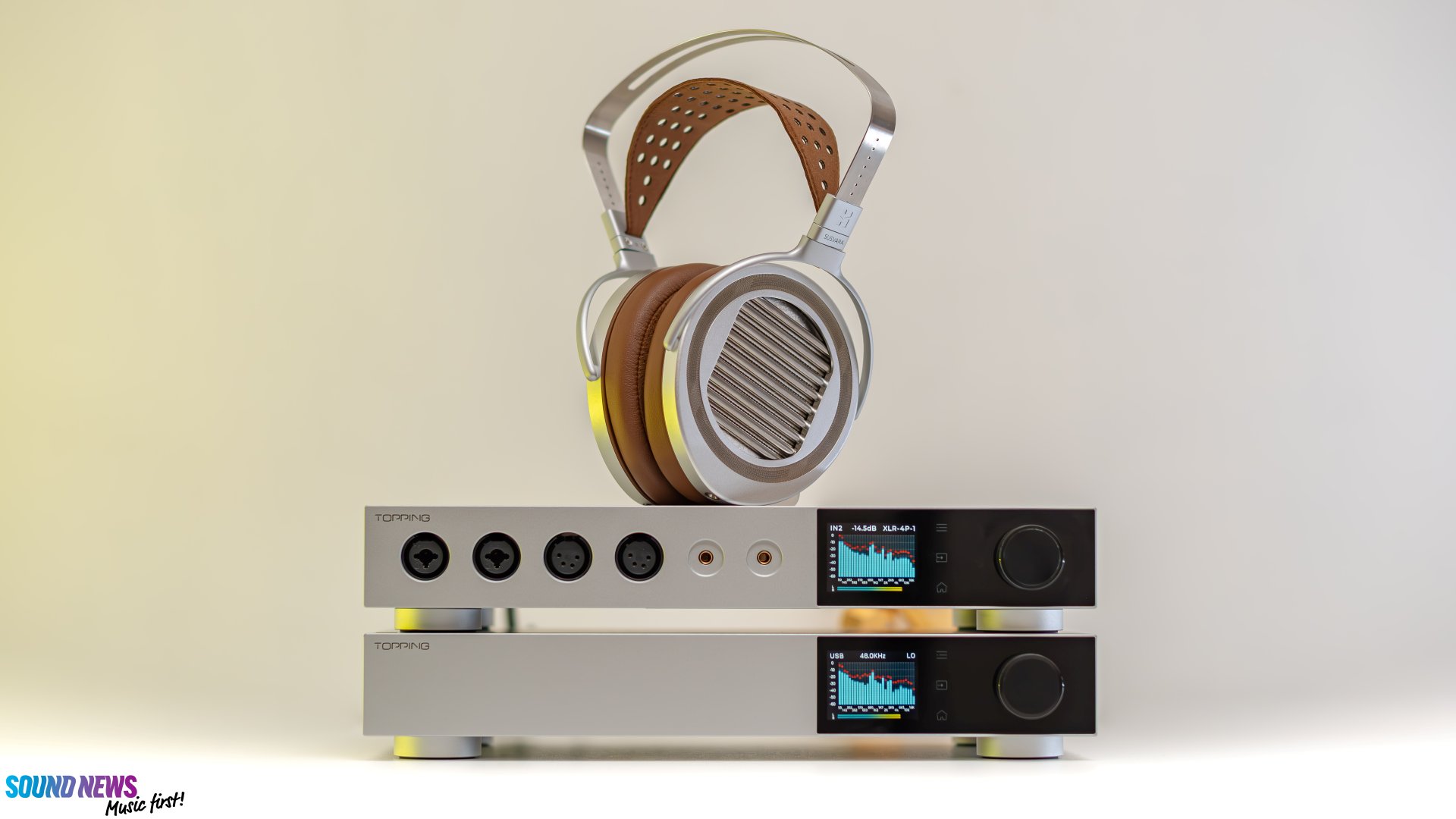
My Conclusion
I was never quite excited for a Topping DAC release, except for the DX9 and later for the D90 III Discrete. Mostly because most of them sounded similar to me, so much so that every new generation was copying its predecessor, down to the smallest details. A new DAC chip there, a new USB receiver chip somewhere else, a slightly different clocking on the third unit with little to no innovation, isn’t exactly a technological leap forward, and that’s why I started checking some other brands.
The D900 is, however, a very different animal compared to anything they’ve done before. The 1-bit architecture was further polished; we now have 32-element PSRM modules instead of 16-element ones on D90 III Discrete, the I/V conversion stage is brand new, and so is the volume control and active preamp stage, which works as a mini amplifier for the voltage output, bumping it up to 13V via XLR if needed.
The sound matured in ways I didn’t imagine Topping ever exploring. I specifically didn’t discuss only its technicalities in this article (which were seriously improved), I also offered lots of subjective listening impressions, trying all sorts of musical genres, just to strengthen my initial impressions and let you understand how big the change was. The D900 isn’t only the best sounding Topping DAC to date and their most feature-packed unit as well, but to some degree, it could be the last unit you’ll ever need, if you don’t fancy overpriced stuff. Let’s not hide around the bush, the D900 is expensive, considerably more versus the D90 III Discrete, and it’s also pricier versus their DX9 limited edition unit. However, do note that everything you see here wasn’t rushed, but carefully selected. This is so far their most uniquely designed unit on the inside; there are fewer off-the-shelf components in there and more custom-made ones, and slowly but surely, Topping paved the road for future DAC developments. They now have the R2R Centaurus, lots of chip-based solutions at various prices, and now we have two single-bit DACs in their portfolio, marketed as their best of the best.
In the near future, I presume Topping will release a successor to the DX9 that could be seen as their best chip-based DAC, and far away in the future, they might reveal a beefier Centaurus PRO or something along those lines, covering the entire DAC market with flagship converters, but that’s a story for another time.
Even the ugly UIs, mediocre remote controls, and subpar cases and heat dissipation mechanics were taken care of. I mean, there’s very little to complain about the D900. I did try my best to find some overlooked features of flaws, and the only one that bothers me is that Parametric EQ (PEQ) doesn’t work with an I2S connection, which is the best digital connection available on the D900. My Rockna Wavedream NET and Onix XST20 both output an I2S signal, and that’s what I used most of the time with the D900, and I was unable to use the PEQ function with these two. I did, however, try PEQ with my PC using the USB connection, and it worked perfectly fine with only a tiny caveat. Once you engage PEQ and load the PEQ config file, the sound loses some crispness, like the resolution and timing of the unit are no longer at 100% but more like at 99%. It’s a subtle effect, but you can still hear it with high-end speakers and headphones. I don’t use PEQ with my speakers or headphones, and for me, this isn’t a big deal. But even in this state, I will wholeheartedly recommend the D900 as one of the best converters I’ve experienced so far.
The Topping D900 was graciously provided by Topping Audio in collaboration with Apos Audio, and it is now available on their web store for $1.799, which includes shipping to your front door and proper support if things are going sideways. If you take the plunge and have some burning questions, feel free to drop me a line in the comments section below. That’s all for now, Sandu’s signing out!
PROS:
- The most stealthy-looking DAC Topping has ever made
- Beautiful, clean lines, impressive craftsmanship, and attention to the smallest details
- Beautiful and easy to navigate UI, feature-packed to its teeth, a metallic remote control is a welcome addition
- Flawless looking on the inside and out, most of its PCB and internal layout was custom-designed from scratch
- Dead silent in both a stereo and a head-fi battle station
- Lacks any kind of distortion or noise, even when used directly with power amplifiers
- The most resolving sounding DAC up to $3000 I have experienced so far, without becoming clinical or dry
- Highly dynamic and enjoyable sounding at all times
- Punchy and tightly controlled in every situation, more so than what Topping has released so far
- Soundstage, imaging, and note separation are as good as they can get
- Covers the frequency response in full, balancing it out in a natural fashion
- Rocks the widest selection of digital inputs and analog outputs
- An incredible bang for your buck
CONS:
- Enabling PEQ will smear a small portion of micro-details
- PEQ doesn’t work with I2S input (this is not Topping’s fault; the I2S connection bypasses every DSP and USB/SPDIF converter chip in the signal path)
ASSOCIATED EQUIPMENT:
- Digital Transport / Roon Server: Rockna Wavedream NET 4 Tb
- Network Switch: Ansuz PowerSwitch D3
- DACs: Topping D900, D90 III Discrete, Gustard R26, Rockna Wavedream Reference Signature
- Headphone Amplifiers: Cayin Soul 170HA, Feliks Envy Performance Edition, Burson Soloist Voyager, Topping A900
- Preamplifier: Chord Electronics Ultima PRE 2
- Power Amplifiers: Chord Electronics Ultima 3 (X2)
- Full-sized headphones: HiFiMan Susvara Unveiled & Susvara OG, HE1000 Unveiled, T+A Solitaire P, Meze Elite, Erzetich Charybdis, Kennerton Rognir, Sennheiser HD800S & many others
- Loudspeakers: Raidho TD 2.2
- Interconnects: Crystal Cable Monet XLR (X2)
- Speaker cables: Crystal Cable Monet 2.5m
- Power Cables: Crystal Cable Monet 1.5m (X4), Neotech NEP-1001 (X2)
- Ethernet Cable: Crystal Cable Monet
- HDMI Cable: AudioQuest Dragon
- Balanced Isolation Power Conditioner: KECES IQRP-3600
- Audio Racks: Woodyard Suspended Triple & Baby Modular
